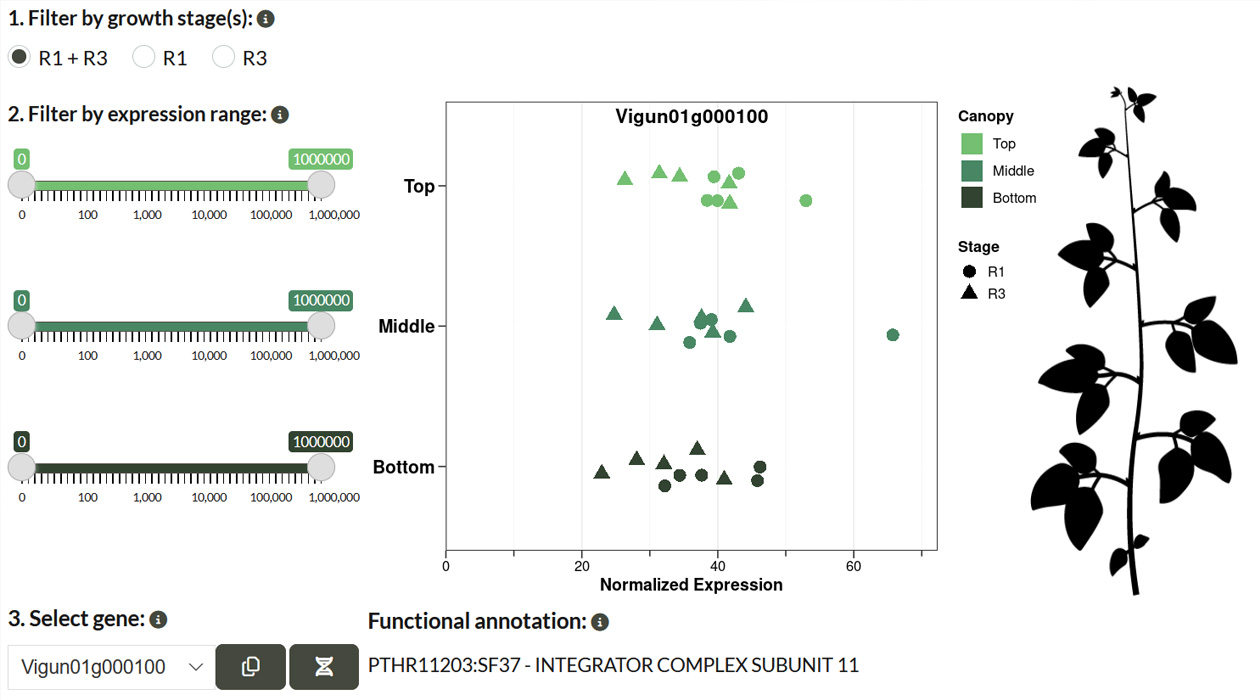Easy Cowpeasy: RIPE team develops new gene expression tool for cowpea

The CowPEAsy web tool, which can display multple genes and levels of plant canopy over a growing season.
A team from the Realizing Increased Photosynthetic Efficiency project has developed a tool that will enable scientists to better explore cowpea gene expression with the click of a button. CowPEAsy is an open-access interactive web tool that allows researchers to look at specific genes within three levels of the plant canopy during two points of the growing season.
“If you have a favorite gene and want to know how it behaves in different light or developmental environments across time, you can input its gene ID in this tool, and it will come up with a visualization of the expression profile incorporating both of those conditions,” said Jake Harris, an Agricultural and Biological Engineering graduate student working on the RIPE project and co-lead author on a recently published paper about the new tool. “This information is incredibly powerful in that it allows researchers to identify upstream regulatory regions that may be responsible for mediating an expression profile of interest.”
RIPE, which is led by Illinois, is engineering crops to be more productive by improving photosynthesis, the natural process all plants use to convert sunlight into energy and yields. RIPE is supported by Bill & Melinda Gates Agricultural Innovations (Gates Ag One).
Previously, most expression datasets have not included associated canopy position or development data. Members of the Leonelli Group, at the University Illinois Urbana-Champaign, collected gene expression data in these conditions and consolidated it in a single place, giving users a way to work with the data without requiring expertise in coding or computational biology. Scientists who have a specific gene in mind can use the tool to check the gene’s expression profile and see how it is expressed under a particular set of conditions. If a scientist doesn’t have a specific gene in mind, the tool can also help them determine a target to focus on based on a desired canopy expression profile.
Most transcriptomics studies have previously focused on the upper canopy, but CowPEAsy demonstrates the dynamic range of expression patterns many genes have, even within a single plant.
“If you’re trying to figure out a way to target the bottom of the canopy to express different things, this type of information is vital,” said Jooyeong Jeong, co-lead author on the paper and a postdoctoral researcher on the RIPE project. “CowPEAsy is a really cool way to look at your gene expression for whatever you’re interested in, but also a way to find regulatory regions that control a pattern of expression.”
Regulatory regions contain information that plants use to control the strength, timing, and location of gene expression. A number of studies have been conducted on the regulatory regions of soybean, but understanding what is controlling gene expression in cowpea will allow for less variability and more predictability, making CowPEAsy a tool with the potential for immediate impact
CowPEAsy is unique in that it considers the three-dimensional world plants grow in out in the field and the varied light environments experienced by a plant. The top layer of a plant’s canopy is blasted by the sun for most of the day, whereas light is more varied in the middle of the canopy, and the bottom layer of the canopy is generally rather dark. Being able to separately consider expression in each of the three levels allows scientists to identify possible regulatory elements (promoters) that can target gene expression at different canopy layers. If a researcher is interested in changing the expression of genes that play a role in photoprotection, a plant’s ability to protect itself from taking in too much light, they would want to be able to target that expression at the top layer of the canopy. Expressing photoprotective genes in other canopy layers could result in the plant wasting energy that could otherwise be used to make sugars.
“Cowpea is a vitally important source of sustenance for certain areas of the world. The more we can learn about how it interacts with its light environment through its gene expression, the better positioned we will be to design strategies to improve its photosynthetic productivity, and in turn, increase its yield,” said Laurie Leonelli (PFS), assistant professor of Agricultural and Biological Engineering and principal investigator for the RIPE project “CowPEAsy is a first step towards building an understanding of gene expression throughout the canopy. These sorts of tools will make it easier for scientists, like ourselves, to develop light-use strategies specific to light environments. We are really excited to see where this leads.”
